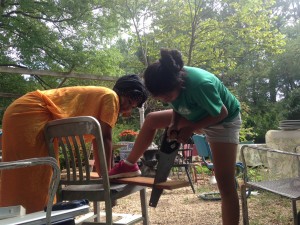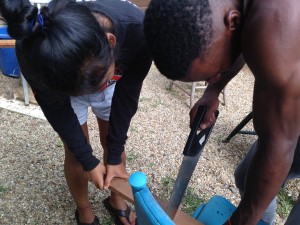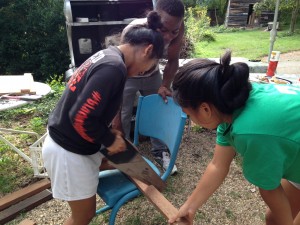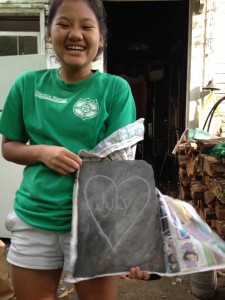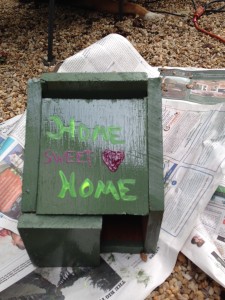Building Experiences is holding a Youth Conference in January and we’re hashing out the structure of the weekend. One student has been vociferously requesting a scavenger hunt so I’ve been trying to figure out an authentic way to include her request in the weekend’s agenda. The scavenger hunt is still in development, but here are some creative ways that I’ve been thinking about modifying the structure:
Category Archives: Education
Announcing Building Experiences
In July I did a very scary thing and left my beloved position as Program Director at Computers4Kids after 6 years of working with some of the best students, volunteers, and mentors in this community.
This fall I have been continuing my work with the youth of this area, and am ready to announce my new venture, Building Experiences. Continue reading
A Week (+ 1) In Pictures
When my brain is too full of words to process, I must resort to pictures. This week has been so amazingly full, inspiring and life-affirming, I haven’t even been able to begin filing it appropriately. Enjoy these pictures of so many amazing people!
The Rookie’s Guide to Ed Theory: Bloom’s Taxonomy
Guess what? You’re probably training someone right now! Are you a shift manager at a restaurant, are you a parent, or will you be working alongside a new hire? Yes? Trainer, trainer, trainer!! This is an occasional series to introduce you to important educational constructs.
Bloom’s Taxonomy
or It’s more than just “understanding”
Bloom’s Taxonomy http://cft.vanderbilt.edu/guides-sub-pages/blooms-taxonomy/ is “a framework for categorizing educational goals”. When I was beginning education grad student, I thought the goal of every lesson was for learners to “understand” stuff. “You know, I don’t know, students will understand that the civil war was really important, for, you know, everyone in the south after it was over.” That’s some pretty content-free stuff right there, which is pretty much how my first teaching attempts went. Continue reading
Motivation: It’s a continuum, not a dichotomy
I remember happily nodding along with the platitudes about intrinsic and extrinsic motivations during grad school. The information fit within my ideals about learning for learning’s sake. Intrinsic motivation– the motivation to learn and perform for a feeling of internal satisfaction– was in my mind the golden standard. Rewarding students, a form of extrinsic motivation, was detrimental to the health of the learner, would sap their love of learning, and would create generations of lab rat-like students performing their tasks for a stipend of sugar-laden M&Ms.
After all these years, my understanding of intrinsic and extrinsic motivation is quite different, Continue reading
Best Practices: Flee
Last week I did something that felt revolutionary, dangerous and bold.
I walked out of an academic conference. Continue reading
7 Steps to Designing or Modifying Objective-Based Activities!!
This past Thursday I was lucky enough to get to present at the NASAGA conference in Baltimore. I’ve been involved with NASAGA since 2004 when I got introduced to this wonderful group of trainers, teachers, and designers. I’d really suggest attending next year’s conference in Seattle if you are wanting an infusion of creativity and inspiration.
This presentation came from seeing the disconnect between activities, learning objectives and evaluation in much of the training that I see. I want to see better matches between what we are teaching and how we are evaluating learner’s performance.
While these are presented as 7 discrete steps, it’s likely that a designer would need to revisit earlier stages to make adjustments as needed.
Determine the Goal
This is the big picture goal. Examples include: Students will develop their reading skills or The team will build stronger relationships. These fall within a continuum that could be goals for 6 or 60 year olds.
Identify Required Prior Knowledge/Analyze the Learners
First the designer must determine where on that continuum the learner lies. Letter Name recognition or college-level comprehension? Are these sales associates just beginning their careers, or are these executives selling at the enterprise level? There are tons of cultural, cognitive, language, developmental factors that you need to be aware of as you design effective learning activities. So who is our audience? And what do they know?
identify Realistic Objectives for the Length of Session and Audience
This is where the designer decides what specific things our participants will be learning or doing. Objectives are performance based and verb-oriented. Some examples of objectives are:
- Recall and state the 50 state capitals of the USA, or recall and state the features of a Ford 150 pick up truck
- Compare and contrast the features of two competing products
- Use proper placement and form while running
- Create a personal goal statement
- Improve confidence in ability to perform
Choose Performance Benchmarks
How do we “grade” our learners? Too often I see scores of multiple choice being the only way we measure learning, when in actuality we really want to know that they can perform tasks in the workplace, or that they are building foundational skills. We do need numbers, or qualitative rubrics, or rated rubrics. I’m enough of a pragmatist to know that we need reportable outcomes to funders– whether they’re our state governments, or donor or our managers. Here are some ways that we can describe performance benchmarks:
- Correctly spell 8 out of 10 words.
- List at least 5 differences between 2 products
- Match at customer attributes to the best available product
- Run a mile in 10 minutes or less
- Create one software routine that can correctly manage user input
Scale Story and Time to Create a Metaphor
The most effective training takes an authentic real-life performance task and scales to the “classroom” so that the class performance most closely relates to what the learner will need to do out in the world. The prime example of this kind of emulation is a simulation– Military video games, or NASAGA member Chuck Petranek’s drinking game. While a video game can give us amazing immersive graphics, it can be as simple as having a chip represent an alcoholic beverage. Sometimes metaphors can become belabored and unwieldy– and the focus becomes on replacing the relationships. We want to have stories that are simple and support the learning objectives– It certainly can be tempting to provide overly complex stories, but scaling back and focusing on the learning objectives helps focus on the important stuff, not building overly elaborate fancy worlds.
Develop Participant Activities
Activities can be individual, team, face to face, online, merged, games. We have whole arsenals available to us. We can do a better job of convincing our stakeholders to use a variety of activities when we can clearly connect them to learning outcomes.
Select Debrief Techniques
How many times have evaluation at the end of a course devolved into a certificate of completion for the student, and a survey for the instructor? That’s not enough .One of the ways that gamification can really be effective is providing a more compelling feedback loop– badges can be great motivators, and can track varying levels of mastery. Points boards can be used effectively (and carefully) to foster competition. BUT, this is only the beginning. If I had my druthers, we would see more integration on training and feedback into the workplace, or school setting. People often see training outside of their workplace performance, and really, it would be good to tie annual reviews/reflection all of the rest into our training.
College Essay, How I Love Thee
Ugh, college essay time! Right? Wrong. I love the process of writing the college essay. The college essay serves lots of purposes. It can explain away a period of poor grades. It can personalize all the numbers. It can provide context for afterschool activities. Most importantly, though, it is the student’s story, as told by and understood by the student.
Writing a college essay can allow students to see themselves differently, to recast their stories, to gain confidence and to feel entitled (in the best way) for the educational opportunities they are pursuing. Grade school has become such a disparate series of parts, that it can be hard for a young student to understand the process and his or her role in it. Oftentimes, the students I work with have experienced some sort of failure or aren’t as competitive as their peers. The college essay allows them to explain the circumstances, and to highlight how they excelled even in the face of adversity.
What’s a string of Bs and Cs in general level classes in the face of the struggles I see? The stories of students I work with are complex, and sometimes heartbreaking. A 20 year-old mother who was impregnated by rape at 13, and is raising the baby, alone, and in a foreign country. A daughter who cried as her father was dragged out of their home and shot dead. A boy who has been responsible for paying for his school supplies and clothes since he was 13 because his family needs any available money for food. A young woman who is the product of generations of rape. A young man who fled his home place because his father was kidnapped and held for ransom. You could meet these students 100 times and never know these things about them because they present as strong, and resilient. And they are strong and resilient, or they wouldn’t have survived.
But their grades are so-so, or their SAT scores are just average, or they haven’t done enough extra-curricular activities to be competitive. The college essay can contextualize that so-so high school performance and demonstrate that that performance, given the pressures, the obstacles, the hardships that were faced, was in fact exemplary, and outstanding, and that young person asking for more education and more opportunity would be an asset to the college.
When young people write their own stories, through the process of the college essay, they can see themselves as worthy, as hard-working, as heroes of their own stories. In turn, they enter a new part of their lives having a sense of their journey knowing that they have already overcome so much, and the challenges of succeeding in school are not insurmountable.
Transitioning Youth to College
I love working with teens and young adults. They are outwardly brave and bold, but secretly vulnerable, still seeking approval and reassurance. They want to be independent and make their own decisions, but they also want to establish themselves on the paths to responsible adulthood.
I tend to work with young people who have circumstances that are different than my own, and maybe yours, at the same age. They are people of color. Or they are young parents. Or they are first generation college students. Or they immigrated to this country. Or they speak another language at home. Or they live below the poverty line. Or they practice a non-Christian religion. Sometimes the students I work with are described as “minorities”, “at-risk”, “low-SES”, “underserved”, “low-income”, “disadvantaged”, “low-achieving”, “under-performing” or any other term that sounds good in a grant application.
I hate using these terms, because it’s othering. These terms make these kids sound “needy”. All 16-22 year olds are needy. They need fully-grown adults to guide them, even when they are jerks, make dumb choices, and say they don’t want help. Conservative pundits talk about people pulling themselves up by the bootstraps, while their own challenging kids attend private schools, experience prestigious unpaid internships and are tutored in every subject.
Teenagers who grow up in homes of privilege, homes where the status quo is to go to college and get a professional job, are exposed to important support, knowledge and experiences that may not available to teenagers who are first generation college students. For example:
- The expectation that they will go to college AND graduate from college,
- The connection between difficulty of classes, GPA and SAT scores on college selection and acceptance,
- Familiarity with college campuses (including visits to alma maters of family members)
- Understanding implications of financial aid such as loans, scholarships, grants, etc,
- Differentiating between for-profit vs traditional colleges,
- Awareness of and importance of a major,
- Knowledge of connection between major, graduate school, certification and ultimate job opportunities,
- Familiarity with college support systems such as career counseling and job placement rates,
- Awareness of the admissions, financial aid, and add/drop deadlines and that the onus is on the student, not the school.
Which of these did you implicitly know? Sure, maybe like me you regretted a few choices but also maybe like me, you had access to and the resources for the following opportunities (privileges):
- Sufficient reading, writing and thinking skills to be immediately successful in college
- A “Gap Year”
- Travel
- Extracurricular classes and Camps
- A home base to return to
- A car
- An allowance or parental loans
- A support person to nag you onto track
- A quiet place to apply to college
- A strong network of entrepreneurs and business owners (I can name at least 5 jobs that I had before the age of 22 that I got because of my network of family and friends)
- Enough financial security to delay entry into the workforce through undergrad and grad school
- The same skin color and cultural background as the majority of business owners and patrons in the lucrative downtown mall district
There are many programs that are doing a lot to help students transition successfully to college: Upward Bound and AVID are two Charlottesville programs that do a great deal to help students, but we can do more. We need to do more.
Building Experiences
As I transitioned out of my role as Program Director at Computers4Kids, I wanted to make sure that I didn’t lose contact with a number of students who I had formed especially close relationships. I had a group of them out to my house on Sunday to “build stuff” as they requested. I provided ingredients for lunch, computers for looking up plans, lumber and simple building tools. Fatuma, college freshman, was our documentarian. Her words and pictures are below.

Fatuma was trying to make this small beautiful doll house, but it kinda didn’t work out, so instead she is making a bird house. 🙂

July is looking for bird house design on the web! P.S. the bird house she made was amazing! The little birds will love it!
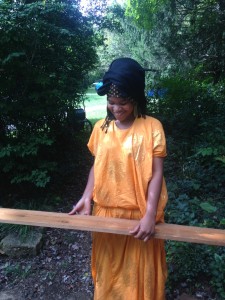
Fatuma trying to get started with her beautiful bird house. There were times when she really wanted to give up but Miss Dolly kept on motivating her! 🙂

Miss Dolly helping July with her bird house plan! If it wasn’t for Miss Dolly, nothing would have gone right! Thanks Miss Dolly, we love you!
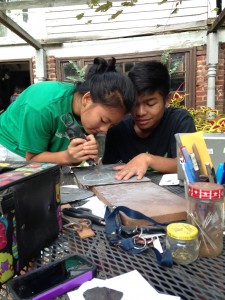
Now this is what I call a amazing teamwork! July helping Zarny with the dremel tool to help it carve better!

Zarny slicing the chicken apart! P.S. he sliced it first and than he asked if he should all cut the chicken into pieces! lol!


